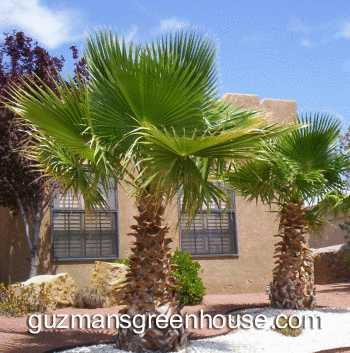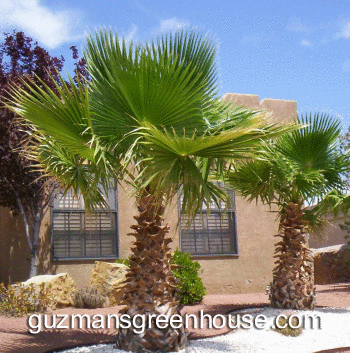
Care of Palm Trees
Care of Palm Trees. In the Desert Southwest, there is no better image than seeing palm trees around pools, courtyards, or a backyard landscape area. A tropical look and an environment that brings thoughts of cool refreshing drinks and family gatherings. Here are some helpful tips for keeping those trees healthy and looking good year-round.
Helpful Palm Tree Tips
Here are some helpful tips for keeping palm trees healthy and looking good all year long.
The Mediterranean, California, and Mexican fan palms will survive the southwestern droughts and are seen throughout the southwestern landscape. However, the Mexican fan palm will struggle if temperatures drop into the lower teens, especially newly planted ones.
Palm trees love good well-drained soil do not plant them in hard caliche soil. Be sure to ask for a good, composted soil conditioner when purchasing palm trees. All palm trees are in the Arecaceae, or cycads family. Palm Trees of the Southwest Photos.
The Date palm or Phoenix palm also does well in the desert southwest. It typically has one or more large trunks that come from one root system.

It can grow up to 20-25ft. tall. The fronds have a feather-like look to them long and narrow perfectly for getting moisture from the light sprinkling of rainwater.
The Sago Palm (Cycas revoluta) is usually used for Bonsai purposes or in ornamental pots, typically indoors. However, in climates where temperatures never go below freezing, it does just fine. Many folks like this type of palm in a container because it does not grow that tall or wide. 4-5 ft. tall and anywhere from 4 to 8 ft. wide. You will have to water more often during the hot summer months.
I have seen Sago palms in places where they freeze but their owner may have protected the palm tree from freezing during its first 3-4 years of growth.

Care of Palm Trees.
Use a good root stimulator to stimulate root growth for these types of trees. Make sure to ask for a “Root Stimulator” at your local nursery. You can purchase this at “Color Your World” nurseries or ask to see these magnificent palms at your local nursery.
Palm trees love full sun and soil enriched with Manganese, Magnesium sulfur, Potassium, and Iron. Most soils do not contain this type of naturally occurring element no matter where you live. A good 12-4-12 analysis is an ideal fertilizer to use. Apply it a few days after you have planted your palm trees.
It is also beneficial to fertilize older palm trees. There are hundreds of palm species but on average, the normal lifespan of most palms is well over 150 years. Some palms can live much longer.
Be sure to ask for palm tree fertilizers when purchasing palm trees. Carl Pool’s Palm Food will work for these types of trees.
Did you know there are over 2,500 species of palm trees? The Arecaceae family of plants includes wonderfully diverse species found throughout the world, from the desert to the rainforest. Here is a post from mnn.com on some amazing facts about these trees. Facts about Palm Trees.
Care of Palm Trees
Palms love to be pruned when the fronds start to turn brown or yellow at the bottom. Be sure to wear a good pair of thick gloves before pruning as the fronds will have large hooked-type thorns.
Palm Trees are susceptible to Ganoderma Root rot. This is usually caused by too much water, especially in places where there is lots of rainfall. In the Southwest this is rare, but it does happen.
Check your watering system to make sure there are no broken lines. Do not place them underneath or near rain gutters and once the tree is in its 4-5 years you can cut down watering to about 1-2 times per week during the hot summer seasons.

How to Trim Palm Trees
Use good sharp cutting loppers. Corona Clipper 32” Professional Bypass Lopper with 2-1/2″ Cutting Capacity is what we recommend.
If your tree is over 15ft. tall, you should call or consult with an arborist or landscaping professional. You should prune fronds at the bottom part of the tree.
If the tree looks brownish at the top this could be an indication of insects or disease or temperatures below 32 degrees Fahrenheit. Do not use small pruning shears.
Do not cut too close to the trunk and only trim old browning-type fronds towards the bottom of the tree. Remember in case of a large over 20ft. or over the tree, you should call or consult with a landscaping professional.
In the Southwest, the Mediterranean and Pindo fan palms are the hardiest followed by the California, Mexican, Sago, and Windmill palms.
All fronds in the southwest need trimming in spring after frost damage The California fan palm also called the Washingtonia filifera can grow up to 50-60ft tall.
The Mexican palm is taller up to 100 ft tall but much narrower. All palms are low water once established. Be sure to remove and dispose of fronds in a large container, you do not want children or pets close to these vicious type thorns.
Dig your hole twice as wide and about the same depth see the photo to the left. About 4′ wide and 3′ deep. Planting a palm tree is basically the same as other types of trees. How to plant a tree post here.
The difference between many palm trees in and around the Southwest.

Here is a post on Mediterranean palm trees.
Remember proper palm tree care, pruning, fertilizing, and maintenance will make your landscaping yard a place to be noticed.
Care of Palm trees requires constant observation and following through with fertilizing, trimming, and proper watering.
If you need any type of advice concerning landscaping, gardening or tree help do not hesitate to contact us. Article by: Paul Guzman
